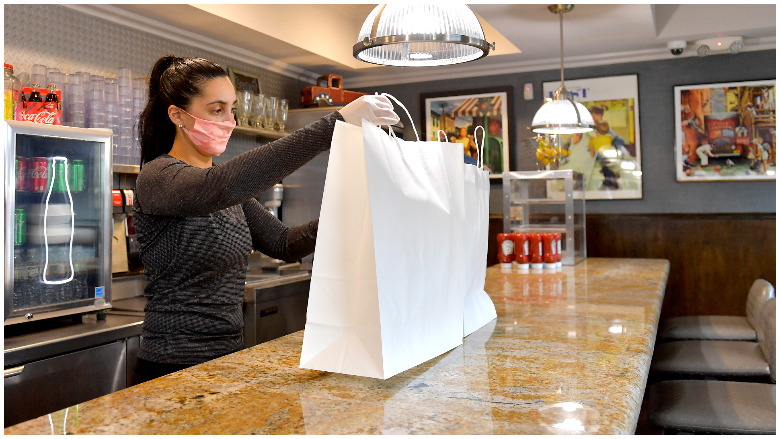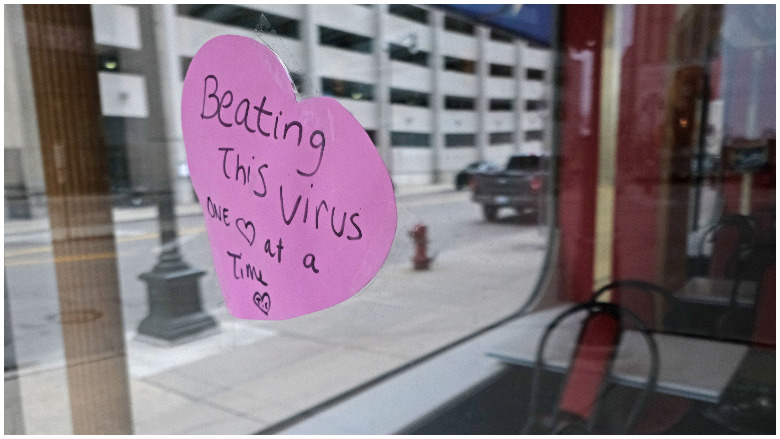
Getty Is takeout food safe for Easter?
Lots of people are ordering takeout food during self-quarantining. That’s also true of Easter brunch or dinner. Restaurants throughout the country are offering curbside, takeout or delivered Easter meals. However, when you get the food, is it safe from coronavirus (COVID-19)? Do you need to sanitize it?
Experts are mixed on the degree to which you need to sanitize takeout food or groceries for that matter. They largely agree that the risk of getting COVID-19 from takeout food – whether Easter dinner or otherwise – is probably small but not zero. They also agree that you have the greatest risk of getting COVID-19 from people-to-people transmission. Thus, if you reduce your contact with people – by picking up Easter meals curbside or having them delivered, for example – that’s probably a good idea. Furthermore, you could sanitize packaging if you want to be extremely cautious. Remove the food from cartons, plastic bags, and the like. Throw the packaging away, put the food on regular plates, and then heat it. Wash your hands all the way through. However, experts don’t seem to believe this is a major risk. The degree of caution you wish to take is up to you.
“We don’t really have any evidence that food or food packaging is a source for getting sick,” from COVID-19, said Benjamin Chapman, a professor and food safety specialist at North Carolina State University, to Live Science.
“There is no evidence that SARS-CoV-2 can be transmitted by eating food. I imagine that if this is possible, the risk is extremely low,” said Angela L. Rasmussen, PhD, a virologist in the faculty of the Center for Infection and Immunity at the Columbia Mailman School of Public Health, to Forbes.
The University of Alabama-Birmingham is among those reporting that: “The risk of contracting COVID-19 through food delivery or pickup — the packaging or the food itself — is low, according to leading health organizations and Jodie Dionne-Odom, M.D., assistant professor in the University of Alabama at Birmingham’s Division of Infectious Diseases.”
“There is no evidence out there, so far with [COVID-19], that it’s foodborne-driven or food service-driven,” Ian Williams, Ph.D., chief of the Outbreak Response and Prevention branch of the United States Centers for Disease Control and Prevention, said in an information webinar, according to that university. “This really is respiratory, person-to-person. At this point, there is no evidence really pointing us toward food [or] food service as ways that are driving the epidemic.”
However, Dionne-Odom does recommend frequent hand washing. “Packages will be coming from a number of hands, and you might not know the symptom status of everyone who touched it along the way. Wash your hands after opening and handling the package. That will kill the germs.” She suggests having a person in the household pick up the food who is not over 60, symptomatic or dealing with underlying health issues.
Another option is to clean packaging, but that might be more work. The Environmental Protection Agency has released a list of cleaners and disinfectants that destroy COVID-19; you can find the list later in this article. You could clean the outside of cans or harder packages, just make sure that you don’t contaminate any food items (you wouldn’t want to put Clorox on fruit for example; we’re talking about the outside of packaging).
One expert, Dan Schaffner, a professor of food microbiology at Rutgers School of Environmental and Biological Sciences, told Vox that he thinks disinfecting your groceries is “being overly cautious” because there are no known cases of COVID-19 being transmitted by food or its packaging.
Here’s what you need to know:
One Expert Has Recorded an Instructional Video on How to Carefully Sanitize Food Items
Another expert, Dr. Jeffrey VanWingen, MD, has prepared a YouTube video on how to sanitize groceries, which might be of use to some people who bought Easter dinner. He borrowed from a medical term called “sterile technique,” which is used in surgeries, and adapted it to grocery shopping. He suggests not using groceries for three days and leaving them in the garage; having a delivery person leave them outside is better. You want contact-free delivery. If you go to the store, wipe down your shopping cart. Stay away from the store if you have signs of respiratory illness, and don’t let people over age 60 shop. Get two weeks of groceries and minimize your time in the store. Once you get the groceries home, sanitize your workplace. Put the groceries on the non-clean side of the table and systematically sanitize them with disinfectant wipes. Wipe down bottles. With items like cardboard cereal boxes, get rid of the box. Cloth bags increase risk and should be consider dirty; put them outside after use. This is all according to Dr. VanWingen. He suggests washing fruit with soap and water for 20 seconds as if it’s your hands.
He said you should imagine the groceries are covered with glitter and strive to get no glitter on you, especially on your face.
The Biggest Issue With COVID-19 Is People-to-People Contact

GettyCoronavirus tips are essential these days.
More importantly, it’s a good idea to limit contact with people, because the virus generally spreads through respiratory droplets. That includes the person delivering the meals.
The U.S. Food & Drug Administration wrote, “… the U.S. food supply remains safe for both people and animals. There is no evidence of human or animal food or food packaging being associated with transmission of the coronavirus that causes COVID-19.” The FDA added, “Unlike foodborne gastrointestinal viruses like norovirus and hepatitis A that make people ill through contaminated food, SARS-CoV-2, which causes COVID-19, is a virus that causes respiratory illness. This virus is thought to spread mainly from person to person. Foodborne exposure to this virus is not known to be a route of transmission.”
If you have a reusable bag, wash it when you get home, or use bags you can quickly throw away.
How should you launder a reusable grocery bag? The CDC advises, “Launder items as appropriate in accordance with the manufacturer’s instructions. If possible, launder items using the warmest appropriate water setting for the items and dry items completely. Dirty laundry from an ill person can be washed with other people’s items.”
As for produce, the FDA also recommends, “Wash all produce thoroughly under running water before preparing and/or eating, including produce grown at home or bought from a grocery store or farmers’ market. Washing fruits and vegetables with soap, detergent, or commercial produce wash is not recommended.”
Coronavirus can Live on Objects & Surfaces, So Sanitizing Easter Meal Packaging Is Not a Bad Idea

GettySecurity guards patrol outside the Huanan Seafood Wholesale Market where the coronavirus was detected in Wuhan on January 24, 2020.
The Centers for Disease Control & Prevention does say that coronavirus may possibly spread through objects, but this is not believed to be the main way that it spreads.
“The virus that causes COVID-19 seems to be spreading easily and sustainably in the community in some affected geographic areas,” CDC notes.
A recent study found that “viable virus could be detected in aerosols up to 3 hours post aerosolization, up to 4 hours on copper, up to 24 hours on 36 cardboard and up to 2-3 days on plastic and stainless steel … Our results indicate that 40 aerosol and fomite transmission of HCoV-19 is plausible, as the virus can remain viable in aerosols for 41 multiple hours and on surfaces up to days.”
VanWingen pointed out that officials found coronavirus particles in a cruise ship 17 days later, so some of the research on this is conflicting.
The Centers for Disease Control and Prevention has an entire page devoted to how coronavirus spreads. The CDC says:
The virus is thought to spread mainly from person-to-person.
Between people who are in close contact with one another (within about 6 feet).
Through respiratory droplets produced when an infected person coughs or sneezes.
These droplets can land in the mouths or noses of people who are nearby or possibly be inhaled into the lungs.
The CDC does add, though: “It may be possible that a person can get COVID-19 by touching a surface or object that has the virus on it and then touching their own mouth, nose, or possibly their eyes, but this is not thought to be the main way the virus spreads.”
The Centers for Disease Control and Prevention says that there is currently no evidence to support transmission through food, however (but that wouldn’t apply to food containers or cans):
Coronaviruses are generally thought to be spread from person-to-person through respiratory droplets. Currently there is no evidence to support transmission of COVID-19 associated with food. Before preparing or eating food it is important to always wash your hands with soap and water for 20 seconds for general food safety. Throughout the day wash your hands after blowing your nose, coughing or sneezing, or going to the bathroom.
It may be possible that a person can get COVID-19 by touching a surface or object that has the virus on it and then touching their own mouth, nose, or possibly their eyes, but this is not thought to be the main way the virus spreads. In general, because of poor survivability of these coronaviruses on surfaces, there is likely very low risk of spread from food products or packaging that are shipped over a period of days or weeks at ambient, refrigerated, or frozen temperatures.
The EPA Has Published a List of Cleaners That Kill Coronavirus

Getty
If you’re looking to sanitize packaging, make sure you turn to cleaners that are known to be effective in killing coronavirus (just make sure they don’t contaminate your food).
The United States Environmental Protection Agency has released an expanded list of disinfectants and cleaners that destroy COVID-19. In addition, the Centers for Disease Control and Prevention has a simple recipe for a bleach and water mixture that kills the virus.
Authorities say that cleaning and disinfection matter a lot because the virus spreads through respiratory drops and can live on surfaces. The new EPA list is known as “List N.”
“When purchasing a product, check if its EPA registration number is included on this list. If it is, you have a match and the product can be used against SARS-CoV-2. You can find this number on the product label – just look for the EPA Reg. No. These products may be marketed and sold under different brand names, but if they have the same EPA registration number, they are the same product,” the EPA states.
You can find the full list here.
“This list includes products with emerging viral pathogen claims and those with human coronavirus claims. If a product with an emerging viral pathogen claim is not available, use a product with a coronavirus claim. If the product is listed as ‘N’ under the Emerging Viral Pathogen Claim column, then it has a human coronavirus claim,” EPA states, noting, “Inclusion on this list does not constitute an endorsement by EPA. There may be additional disinfectants that meet the criteria for use against SARS-CoV-2. EPA will update this list with additional products as needed.”
There are more than 270 entries on the EPA’s list.
The CDC adds: “Community members can practice routine cleaning of frequently touched surfaces (for example: tables, doorknobs, light switches, handles, desks, toilets, faucets, sinks) with household cleaners and EPA-registered disinfectants that are appropriate for the surface, following label instructions. Labels contain instructions for safe and effective use of the cleaning product including precautions you should take when applying the product, such as wearing gloves and making sure you have good ventilation during use of the product.”
Here’s the EPA’s previous list of “Registered Antimicrobial Products for Use Against Novel Coronavirus SARS-CoV-2, the Cause of COVID-19.” Explains CDC, “Products with EPA-approved emerging viral pathogens claimspdf iconexternal icon are expected to be effective against COVID-19 based on data for harder to kill viruses. Follow the manufacturer’s instructions for all cleaning and disinfection products (e.g., concentration, application method and contact time, etc.)” (Note: You can find some recipes for homemade hand sanitizer here.)
READ NEXT: Can You Get Coronavirus From Money?